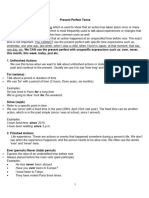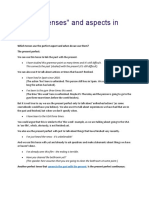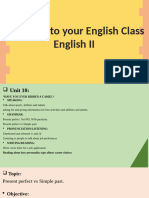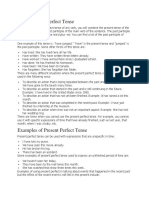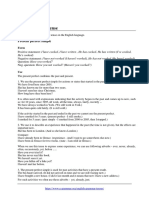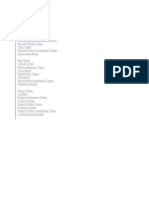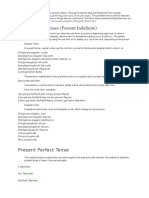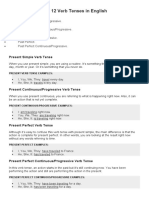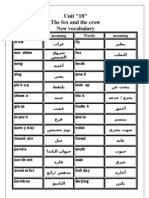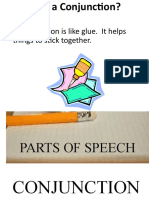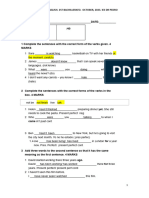0 ratings0% found this document useful (0 votes)
143 viewsThe Present Perfect Tense
The Present Perfect Tense
Uploaded by
Hugo AldereteThe Present Perfect Tense in English deals with three different time periods: 1) an event that began in the past and continues to the present, 2) a time period that is not completed, and 3) an action that occurred at an unspecified time in the past. It uses a form of "have" plus the past participle of the main verb. It is often confused with the Simple Past Tense but the Present Perfect does not specify an exact time. Questions in the Present Perfect follow the pattern of optional question word + have/has + subject + past participle.
Copyright:
© All Rights Reserved
Available Formats
Download as PDF, TXT or read online from Scribd
The Present Perfect Tense
The Present Perfect Tense
Uploaded by
Hugo Alderete0 ratings0% found this document useful (0 votes)
143 views17 pagesThe Present Perfect Tense in English deals with three different time periods: 1) an event that began in the past and continues to the present, 2) a time period that is not completed, and 3) an action that occurred at an unspecified time in the past. It uses a form of "have" plus the past participle of the main verb. It is often confused with the Simple Past Tense but the Present Perfect does not specify an exact time. Questions in the Present Perfect follow the pattern of optional question word + have/has + subject + past participle.
Original Title
Present_perfect_pdf
Copyright
© © All Rights Reserved
Available Formats
PDF, TXT or read online from Scribd
Share this document
Did you find this document useful?
Is this content inappropriate?
The Present Perfect Tense in English deals with three different time periods: 1) an event that began in the past and continues to the present, 2) a time period that is not completed, and 3) an action that occurred at an unspecified time in the past. It uses a form of "have" plus the past participle of the main verb. It is often confused with the Simple Past Tense but the Present Perfect does not specify an exact time. Questions in the Present Perfect follow the pattern of optional question word + have/has + subject + past participle.
Copyright:
© All Rights Reserved
Available Formats
Download as PDF, TXT or read online from Scribd
Download as pdf or txt
0 ratings0% found this document useful (0 votes)
143 views17 pagesThe Present Perfect Tense
The Present Perfect Tense
Uploaded by
Hugo AldereteThe Present Perfect Tense in English deals with three different time periods: 1) an event that began in the past and continues to the present, 2) a time period that is not completed, and 3) an action that occurred at an unspecified time in the past. It uses a form of "have" plus the past participle of the main verb. It is often confused with the Simple Past Tense but the Present Perfect does not specify an exact time. Questions in the Present Perfect follow the pattern of optional question word + have/has + subject + past participle.
Copyright:
© All Rights Reserved
Available Formats
Download as PDF, TXT or read online from Scribd
Download as pdf or txt
You are on page 1of 17
The Present Perfect Tense
The Mystery Tense of the English Language
The Present Perfect Tense is not easy!
The Present Perfect Tense in English is one of those
grammar structures that would not exist in languages
that are designed by people.
Unfortunately, languages evolve with use and the
Present Perfect Tense has evolved into a tense that
deals with three totally different segments of time
that have practically nothing to do with one another.
Situation 1 to use the Present Perfect
Tense
An event begins in the past and continues up
to the present moment
Example: I have been here since 7 a.m.
Key Words that indicate this situation:
since + date, for + a period of time, all + a
period of time
Situation 2 to use the Present Perfect
Tense
When a portion of time is not completed
Example: I have spoken to Lise many times
this week.
Key Words that indicate this situation:
today, this semester, this winter, this year
Situation 3 to use the Present Perfect
Tense
When there is an action or repeated action in
the past with NO SPECIFIC time (the exact
time that the event happened is NOT
important)
Examples: They have moved into a new
apartment. I have seen that movie 10 times.
Situation 3 to use the Present Perfect
Tense (continued)
Notice how in this sense of the tense, the
action can happen one or several times.
Key Words that indicate this situation:
already, just, lately, of late, recently, always,
never, yet, once, twice, three times, many times,
often, several times
The Present Perfect and the Simple
Past Tenses.
These two tenses occupy a very similar place
in time. It is very easy to confuse them. The
major difference between them is that the
Present Perfect Tense doesn't mention exact
times of actions.
The Simple Past mentions or implies an exact
time of an action.
Examples of the Simple Past:
Last month he went shopping.
He went to Boston yesterday.
He gave her the gift there.
Notice that the indication of time is not directly
mentionned in the last sentence.
Example of the Present Perfect:
He has gone to Boston several times.
Notice that the precise time of these trips cannot
be determined.
The Structure of the Present Perfect
Tense.
Part One of the Tense is the present tense of
the auxiliary 'to have'
I have, You have, He She or It has, We have, You
have, They have.
Part Two of the Present Perfect Tense is the
Past Participle Form of the verb.
Possible Past Participle Problems
In irregular verbs the Past Participle is often
different from the Past Form of the verb.
To run - Ran - Run,
To begin - Began - Begun,
To eat - Ate - Eaten
Real Past Participle Problems
In regular verbs the Past Participle form of the
verb and the Past Form of the verb are
identical.
To revolt - Revolted - Revolted,
To like - Liked - Liked,
To work -Worked - Worked
Here are declarative sentences in the
Present Perfect Tense using these examples:
He has run to the store all his life.
He has begun to get tired of always being the
one who does it.
They have eaten well since he arrived
because of all of his work.
You have revolted everyone who has worked
with you this year.
No one has liked you since you started this
project.
Why don't we put started into the
Present Perfect Tense.
No one has liked you since you started this
project.
The action of starting is
completely in the past!
Questions in
the Present Perfect
Question word (optional) + Part 1 + Subject
+ Part 2 + Rest of Sentence
Where have you gone to do the work?
Have you gone to do the work?
What have you done to change the situation?
Where has he been since the accident?
Has he been sad for a long time?
‘Who’ and ‘What’ in questions
Note that sometimes 'Who' and 'What' can be
the subject of the sentence which changes the
word order.
Who has done the work since she left?
What has happened for all this period?
In negative sentences the word not
goes between the Part One and
the Part Two of the verb tense.
Examples: We have not worked there.
She has not liked him since that day.
These answers can be contracted in the
following way:
We haven't worked there.
She hasn't liked him since that day.
You might also like
- Filetype PDF Cambridge English Advanced Grammar in Use OptimizedDocument2 pagesFiletype PDF Cambridge English Advanced Grammar in Use OptimizedJennifer0% (2)
- Chapter 6 Present Perfect TenseDocument3 pagesChapter 6 Present Perfect Tenseapucila4No ratings yet
- Overview of English Verb Forms: Past Present Future Simple Continuous Perfect Perfect ContinuousDocument11 pagesOverview of English Verb Forms: Past Present Future Simple Continuous Perfect Perfect ContinuousAin roseNo ratings yet
- Present Perfect Simple ContinuousDocument17 pagesPresent Perfect Simple ContinuousLiliana RaduNo ratings yet
- Aspects of TensesDocument4 pagesAspects of TenseszoroNo ratings yet
- The Structure of The Present Perfect TenseDocument7 pagesThe Structure of The Present Perfect TenseEdward VarelhNo ratings yet
- Tenses PresentDocument6 pagesTenses Presentleyla azhdarovaNo ratings yet
- Eleventh 7th REviewDocument6 pagesEleventh 7th REviewDaniel SierraNo ratings yet
- CSC GrammarDocument5 pagesCSC Grammarsandra seguienteNo ratings yet
- Present Tenses ExplainedDocument7 pagesPresent Tenses ExplainedKisaidy PeñaNo ratings yet
- Verb Tenses: How To Use The 12 English Tenses With Useful Tenses ChartDocument37 pagesVerb Tenses: How To Use The 12 English Tenses With Useful Tenses ChartAdelina Elena GhiuţăNo ratings yet
- Tugas Summary 1-11Document17 pagesTugas Summary 1-11sherinaNo ratings yet
- Present Perfect and ContinuousDocument46 pagesPresent Perfect and Continuouspmalencar100% (3)
- Present Perfect FORM (Has/have + Past Participle (V3) ) USE 1 Unspecified Time Before NowDocument19 pagesPresent Perfect FORM (Has/have + Past Participle (V3) ) USE 1 Unspecified Time Before NowglbulupnrNo ratings yet
- Present Perfect FormDocument7 pagesPresent Perfect FormmccabeandmrsmillerNo ratings yet
- Present Perfect: Have You Seen That Movie Many Times?Document9 pagesPresent Perfect: Have You Seen That Movie Many Times?Iulia NojeNo ratings yet
- Tenses UietDocument27 pagesTenses UietMohitNo ratings yet
- Communicative Grammar EnglishDocument35 pagesCommunicative Grammar EnglishTran Minh ThanhNo ratings yet
- Student Material TensesDocument14 pagesStudent Material Tensespramoth.sixphraseNo ratings yet
- 12 Basic Tenses and Verb TensesDocument9 pages12 Basic Tenses and Verb TensesniensjvrNo ratings yet
- Present Perfect and ContinuousDocument45 pagesPresent Perfect and Continuouscorrnelia1No ratings yet
- Present Perfect TenseDocument9 pagesPresent Perfect TenseDost Jan100% (1)
- Simple Past Tense .....Document14 pagesSimple Past Tense .....File StorageNo ratings yet
- Engleski Gramatika Sva VremenaDocument13 pagesEngleski Gramatika Sva VremenaMirjana BrčićNo ratings yet
- UntitledDocument14 pagesUntitledAULINO JÚLIONo ratings yet
- Perfect Tenses and AspectDocument5 pagesPerfect Tenses and Aspectaquiles borgonovoNo ratings yet
- Present Perfect Simple & ContinuousDocument20 pagesPresent Perfect Simple & Continuousbuendia8986% (7)
- English Tense System-Present TenceDocument17 pagesEnglish Tense System-Present TenceSujan AcharyaNo ratings yet
- Presentación10 English 2Document27 pagesPresentación10 English 2befogob166No ratings yet
- Present Perfect TenseDocument9 pagesPresent Perfect TenseHizkiel SembiringNo ratings yet
- Review of English TensesDocument8 pagesReview of English TensesSyifaa' NajibNo ratings yet
- Using Present Perfect TenseDocument2 pagesUsing Present Perfect TenseSyrah LumanlanNo ratings yet
- TensesDocument16 pagesTensesMisham Gupta100% (1)
- GramarDocument44 pagesGramarOlga ChirondaNo ratings yet
- Present Perfect Tense PDFDocument3 pagesPresent Perfect Tense PDFRistaNo ratings yet
- TensesDocument50 pagesTensesAndinipuspitasariNo ratings yet
- Verb Tenses EnglishDocument41 pagesVerb Tenses EnglishSAIF KHAN100% (1)
- Verbs Come in Three TensesDocument12 pagesVerbs Come in Three TensesKaiswan GanNo ratings yet
- Present Tense PaperDocument18 pagesPresent Tense PaperMega PuspiytaNo ratings yet
- Present Perfect Unfinished TimeDocument5 pagesPresent Perfect Unfinished TimePedro MujicaNo ratings yet
- What Is The Present Perfect TenseDocument6 pagesWhat Is The Present Perfect TenseGareth JoseNo ratings yet
- Present Perfect Tense1Document7 pagesPresent Perfect Tense1Carlos Andrés Martínez SernaNo ratings yet
- Pet Grammar PointsDocument69 pagesPet Grammar PointsTatiana ZaraNo ratings yet
- Present PerfectDocument18 pagesPresent PerfectPopescu DanielaNo ratings yet
- Presentperfect Simple-Continuous 2Document22 pagesPresentperfect Simple-Continuous 2libra210No ratings yet
- Presentperfect Simple-Continuous 2Document22 pagesPresentperfect Simple-Continuous 2Äyä GamalNo ratings yet
- Past Perfect Simple and Past Perfect ContinuousDocument5 pagesPast Perfect Simple and Past Perfect ContinuousOctavia MirunaNo ratings yet
- UNIT 1 - Grammar ReferenceDocument11 pagesUNIT 1 - Grammar ReferencekateNo ratings yet
- Present Perfect To Future Perfect ContinuousDocument7 pagesPresent Perfect To Future Perfect ContinuousFiona FedericoNo ratings yet
- English Tense SystemDocument26 pagesEnglish Tense SystemJordan CruzNo ratings yet
- Presentperfect Simple-Continuous 2Document22 pagesPresentperfect Simple-Continuous 2riki aprido100% (1)
- The 12 Verb Tenses in English: Present Simple Verb TenseDocument10 pagesThe 12 Verb Tenses in English: Present Simple Verb TenseAl HopkinsNo ratings yet
- New Microsoft Word DocumentDocument6 pagesNew Microsoft Word DocumentCanioNo ratings yet
- VERB Tenses 2Document31 pagesVERB Tenses 2BagasWicaksana100% (1)
- Use of Tenses: Hafiz Muhammad Naveed AhsanDocument86 pagesUse of Tenses: Hafiz Muhammad Naveed Ahsankanwal hafeezNo ratings yet
- Perfect PassiveDocument7 pagesPerfect PassiveFelisitasDianaEffendiNo ratings yet
- Present Perfect 101: Form The Present Perfect Simple Is Made With - Has/have + Past ParticipleDocument3 pagesPresent Perfect 101: Form The Present Perfect Simple Is Made With - Has/have + Past ParticipleAdam CahillNo ratings yet
- Past Simple TenseDocument17 pagesPast Simple TenseAPRILIA NURULNo ratings yet
- Present PerfectDocument9 pagesPresent PerfectOmar AchirNo ratings yet
- HabenDocument2 pagesHabenoğuzhan oğuzhanNo ratings yet
- ArticlesDocument17 pagesArticlesDebashishParidaNo ratings yet
- Name: Krizah Marie C. Caballero Course & Section: BSA 1A: Reaction PaperDocument1 pageName: Krizah Marie C. Caballero Course & Section: BSA 1A: Reaction PaperKrizahMarieCaballeroNo ratings yet
- Avaliaçao 1 (A1) Valor 3, o 1o Trimestre 7o AnoDocument3 pagesAvaliaçao 1 (A1) Valor 3, o 1o Trimestre 7o AnoMARIA CRISTINA PEREIRANo ratings yet
- English Grammar Workout 7 GradeDocument3 pagesEnglish Grammar Workout 7 GradeGabriel Jesús Morales MoralesNo ratings yet
- Ead Grammar v1Document225 pagesEad Grammar v1RajaImranNo ratings yet
- Irregular Plurals 1 Wordsearch Wordsearches - 56476Document4 pagesIrregular Plurals 1 Wordsearch Wordsearches - 56476mohammed el addiouiNo ratings yet
- Unit "18" The Fox and The Crow New VocabularyDocument6 pagesUnit "18" The Fox and The Crow New Vocabularyapi-25887805100% (1)
- AdverbDocument9 pagesAdverbchandramouliNo ratings yet
- BK - 1 - Ch.3-E304ADocument35 pagesBK - 1 - Ch.3-E304ANouraNo ratings yet
- Escrita II ResumenDocument13 pagesEscrita II ResumenBárbara AvilaNo ratings yet
- Toefl Test of English As A Foreign Language Speaking TPO Practice Lesson 1Document16 pagesToefl Test of English As A Foreign Language Speaking TPO Practice Lesson 1Joan Marie SeloterioNo ratings yet
- AindraDocument7 pagesAindraNiran ChueachitNo ratings yet
- Active Voice Vs Passive VoiceDocument5 pagesActive Voice Vs Passive VoiceOs MarNo ratings yet
- CD ManualDocument58 pagesCD Manualparamata priya madhuriNo ratings yet
- Common and Proper Nouns Lesson PlanDocument1 pageCommon and Proper Nouns Lesson PlanMicah PraiseNo ratings yet
- English-7-SLR-Q1 - B2 0Document31 pagesEnglish-7-SLR-Q1 - B2 0Tipa JacoNo ratings yet
- 2-Module Тест Теор Гр 21Document2 pages2-Module Тест Теор Гр 21Aziza ZholtaiNo ratings yet
- Be Going ToDocument2 pagesBe Going ToDayana ElizabethNo ratings yet
- A Conjunction Is Like Glue. It Helps Things To Stick TogetherDocument30 pagesA Conjunction Is Like Glue. It Helps Things To Stick TogetherChie ChieNo ratings yet
- LP02 Types of Nouns ENG G10 Richmindale - Rev0Document13 pagesLP02 Types of Nouns ENG G10 Richmindale - Rev0Gabriella PenaNo ratings yet
- MTA RevisionDocument5 pagesMTA Revisionpinkyfey1995No ratings yet
- Nouns: The Category of Number: Ves, Pronounced (VZ)Document8 pagesNouns: The Category of Number: Ves, Pronounced (VZ)Patricia AcasandreiNo ratings yet
- Japanese Grammar VerbsDocument55 pagesJapanese Grammar VerbsRodrigo Nieves AvendañoNo ratings yet
- Cse 322Document2 pagesCse 322Srujan ReddyNo ratings yet
- English Language Year 13Document25 pagesEnglish Language Year 13Joe WheelerNo ratings yet
- Unit 9 Rules and RegulationsDocument28 pagesUnit 9 Rules and RegulationsAndres Sebastian Davila FalconesNo ratings yet
- EAPP-Lesson-1-Differentiate-Language-Used-in-Academic-Text-from-Various-DisciplinesDocument5 pagesEAPP-Lesson-1-Differentiate-Language-Used-in-Academic-Text-from-Various-Disciplinesin.lihaylihayNo ratings yet
- Examen Unit 1 1ST Bach OrdinarioDocument4 pagesExamen Unit 1 1ST Bach Ordinarioyasuo.lol.31100No ratings yet

